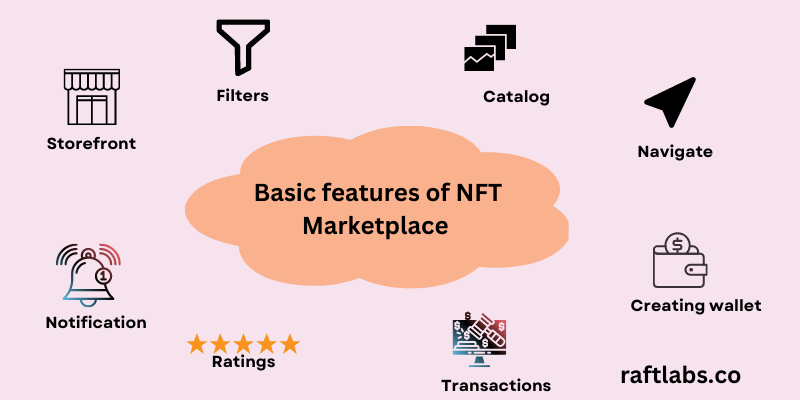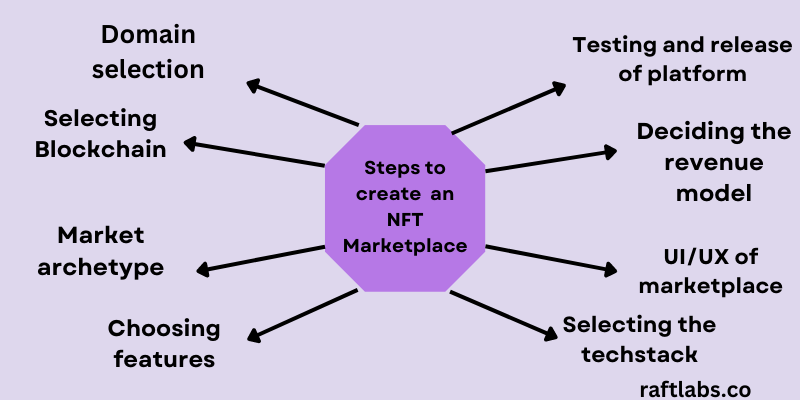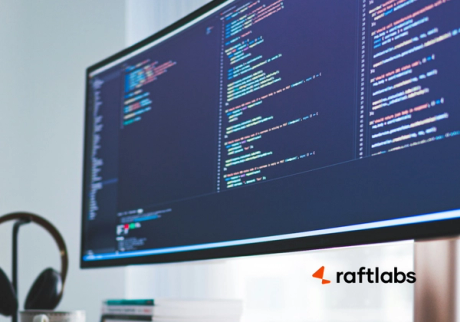Ultimate Guide: Creating NFT Marketplace Platform- RaftLabs
NFTs are Non-Fungible Tokens means they can't get duplicated, copied, or forged around the network with or without consent. Their transactions at NFT Marketplace, get recorded in the Blockchain, which tells people about their ownership and authenticity.
But what if we want to trade digital assets and purchase some of them?
Here the concept of NFT marketplace comes into play where we combine NFTs and our tokens to build a secure platform for people to get engaged in the transactions until they are satisfied. Developing an efficient NFT marketplace is a tedious task. A developer needs to keep in mind many things, including choosing the suitable Blockchain for his marketplace, whether it will be an open marketplace or a closed one that will have limited currency options, etc.
Let's get an overview of the NFT marketplace and its role in the evolution of Blockchain technology.
What is NFT Marketplace?
This Marketplace functions over an existing or a newly created Blockchain. NFT Marketplace, for example, Open Sea, works in an open marketplace atmosphere. People can store and sell their NFTs anytime they want and trade tokens based on customer demand. NFT Marketplace has this safe, close-knitted environment for efficiently promoting transactions, big or small. A crypto wallet is needed to store and trade NFT tokens, which users can make on platforms like Metamask.
How does an NFT marketplace function?

Here are listed some of the widespread and easy steps that a user needs to follow for doing transactions on NFT Marketplace:
1. Log in to your account on the platform with the correct details and initials. Add an extension of your digital wallet or download the app of your choice for your wallet, and remember to add it to your NFT marketplace.
2. Upload the digital assets or NFTs for exhibition and set the price if the platform allows. Users are also advised to select the token currency they want to receive during transactions.
3. Now you are all set to sell your products and transact. Whenever the item is sold, the user will see the details of the transaction in his wallet, and it will undergo a private transaction on a smart contract.
4. The marketplace will add the NFT token details when the user puts out that token for the final auction.
Some basic key features of NFT Marketplace
Now that you know what an NFT Marketplace is and how it functions, it is necessary to understand your customer's needs directly and offer them services accordingly.

Important features of an NFT Marketplace
Here are some key features of NFT marketplace site or app development that you have to keep in mind while building your Marketplace for the users to undergo smoother transactions on the platform:
Basic storefront: The Storefront should contain all the information regarding owners, bidders, item price, and preview history. It can be simple but attractive with a user-friendly interface.
Signup feature: There should be an essential signup feature so that the users can log in to their account anytime they want to and view their digital assets.
Catalog: Users need the marketplace to display the NFTs with high ratings and details in a compact catalog-like structure.
Filters: Users should have the flexibility to set their filters to navigate the site for collectibles. We can select the items by payment methods, listing status, category, and collection by adding the features of the filter.
Navigating the items: NFT Marketplace should have a search bar that supports tagging and category management so that users can search for their tokens easily.
Making your NFTs: Users should have an option in your marketplace to mint their own NFT tokens and create listings. We can fill in the token information, such as the name of the NFT, tags, and description.
Transactions such as buying and bidding: Buy and bid are one of the essential features of the NFT Marketplace. We should be able to see the bid's expiration date and the auction's current status for a particular NFT token.
User Wallet: The users must have access to their wallet to use a specific currency for selling and buying non fungible tokens. We can also ask the users to integrate their wallets on Metamask, Coinbase, Formatic, etc.
Ratings: This feature will be handy when users need to know which NFT token to purchase. We can highlight the NFTS, which are mostly in demand and can easily reward the best sellers and prove their reliability.
Notification: A notification feature in the marketplace will alert users about the new prices and auction details on the newly added NFT tokens.
Support: An efficient marketplace will always have a support feature where users can ask their queries regarding their technical doubts, minor conflicts, and how to operate the marketplace.
After discussing the basic key features of an NFT Marketplace, it is time to move on to your marketplace project's technical needs.
Technical Stack of NFT Marketplace
Blockchain Platforms:
Ethereum: It is the most popular and trustable Blockchain for development where transaction history is visible for the users to claim and prove their ownership easily. Ethereum blockchain rarely goes down and is one of the favourite platforms for users to build on their marketplaces.
Polygon: It is a layer-2 Blockchain and works on proof of stake. It is used as the Blockchain platform for NFT Marketplace development and contains the feature AirNFTs through which users can directly mint their tokens on the network.
Flow: It is a decentralized blockchain designed for creating various Dapps and NFT Marketplaces using a Cadence programming language.
Tezos: It is an open-source blockchain open for its users and developers to make new changes and has a significant scope of research and development. It uses a pre-compiled FA2 NFT contract written in LIGO Smart contract language.
Storage platforms:
IPFS: It is a peer-to-peer hypermedia protocol through which we can store the media content in a decentralized manner giving stress to the security aspect of the storage system. IPFS has to intervene while keeping NFTs as media on NFTs cannot be stored directly, and the IPFS platform can store all the data.
Filecoin: We can store critical information like media files in a decentralized manner with the help of Filecoin. Users can get effortlessly comfortable with this cloud-based service of Filecoin, which provides the developers with all the necessary features of NFT Marketplace creation.
Pinata: It is a popular platform for uploading and managing files on IPFS and provides users with secure and verifiable files for NFTs.
NFT Standards:
ERC-721
ERC-1155
FA2
dGoods
TRC-721
Front end:
React
Angular
Vue
Javascript
Bootstrap
Back end:
NodeJS
ExpressJS
Java
GO
Databases:
PostgreSQL
MySQL
NoSQL: MongoDB
NFT Marketplace Development cost and timelines
The cost of creating an NFT marketplace may vary between US $50,000 - 500,000. Still, it depends on the developers and the users about what services and features they want to include and if they wish for a ready-made or brand-new solution.
If the customer wants to build their marketplace from scratch, the overall development cost will be higher than usual.
Most of the NFT platforms have the same features for transactions and minting, but you need to extend your budget if the concept of your platform asks for a more complicated solution than a usual marketplace. Tools and technology are an indicator of the probable cost of NFT Marketplace.
Getting started with building the NFT marketplace

Summarized steps to create an NFT Marketplace
Let's get started on building our marketplace from scratch-
Selecting the niche of marketplace
Before building an NFT marketplace, we need to check the domain on which we want to build the marketplace. Make sure to ask developers about the concept they have in mind.
What kind of NFTs and digital artwork do they want to add to their marketplace to make it stand out from their possible competitors? Engage everyone in healthy discussions and strategize a plan on what you want to offer to your potential customers before starting to build a marketplace.
Approaching an NFT Marketplace development company
If you have the idea of developing a marketplace but need to learn how to implement it practically, then you will need a team of developers to make a marketplace.
There are several options for building an NFT platform, including hiring freelancers or in-house developers or seeking guidance from an NFT marketplace development company.
Blockchain which best suits the marketplace:
It depends on the developers on which Blockchain they want to make the marketplace architecture. It is the most complicated step of the initial development stages, affecting every other part of the project. Many options are available nowadays, like Ethereum, Solana, and Polygon, which are quite flexible from a developer's perspective.
This proves to be expensive sometimes. Integration into the existing Blockchain is complex and requires a lot of skilled professionals. We should also not forget the part where the concept of 'Gas Fees' comes into play which is quite a lot to deal with. Developers who are thorough with tips and tricks to reduce the cost of Gas fees are the actual heroes here.
To reduce the hassle, there is one more option. Making your Blockchain and investing in the same seems interesting, but this should be safe from all third parties and win the users' trust, which is a dicey game. Prefer to use an existing Blockchain and mold the marketplace accordingly.
Choosing your market archetype: Open or Closed market
Now the question arises of what type of market you prefer for the smoother functioning of your NFT Marketplace.
By closed Marketplace, we mean that the developers are keeping the option of using a particular sort of token or currency and limiting the users to a specific set of tickets.
In an open marketplace, users can do transactions on various existing tokens and create their own tokens depending on their needs. For example, Open Sea has allowed users to use over 150 tokens.
There is no concept of having fixed prices over the NFTs as the closed market does, and the customers can set the cost of their digital artwork accordingly.
This supply and demand pricing model help make the NFT tokens compatible with the Blockchain to which they are getting added. The issue of compatibility in trading structure is dissolved with the Open market architecture of Marketplace.
Deciding the important features of NFT marketplace:
People must decide within their teams about the features they think would make a difference in their marketplace from the rest. Including must-have features should be the priority, and the customer can add the rest of the new features according to the budget that the customer has set for his marketplace.
Choosing the technologies to create NFT Marketplace:
Choosing your technical stack before starting to work on the marketplace model is essential. Developers need to keep in mind the in-demand technologies for the ultimate development of a strong foundation of marketplaces. Pick the best front-end and back-end technologies for NFT Marketplace development.
Styling and Setting layout of the marketplace:
Next, we need to work on the UI and UX of the site. An attractive and user-friendly interface will invite many people to the platform and increase traffic. Developers need to work on the frontend part of things, where they will decide the look and feel of the marketplace and how various icons and transactions will be presented to the users.
Deciding the revenue model :
How much the marketplace should charge and how the developers will collect the gas fees will depend on the monetization model we will include in the marketplace after developing it.
People must remember that the market should be feasible enough for various groups depending on their needs. The financial model should be expensive such that it has a competitive edge to it while being reasonable at the same time.
Listing fees, transaction fees, setup fees, bidding charges, ads can be the monetization model of our marketplace where we can charge a certain amount of money for the services we are providing on selling, buying and bidding. Even listing of the NFT tokens requires gas fees nowadays which can be included in the marketplace.
Emphasis should be given to the security factor of the marketplace, which makes your marketplace stand apart from the existing platforms available to date.
Testing the App:
We need to have QA testers to find any bugs in the app and fix them before our marketplace is released. This ensures that the best product is served to the customer.
Making connections:
Lastly, building a healthy community of buyers and bidders is essential for smoother marketplace functioning. The NFTs and the digital assets should be competitive enough for the people to choose your marketplace before going to any other platform to buy them.
Maintenance of the marketplace:
It is essential to maintain the marketplace after it is launched. You should fix the bugs from time to time and keep adding new features to enhance the working of your marketplace. Security should be the topmost priority of the marketplace provider to secure the assets of the buyers and sellers there. It is an ongoing process where you need to constantly work on the functionality, performance, and scalability of the performance of the marketplace.
Concluding
Trading of NFTs is in trend due to the uniqueness of the marketplace and the ever-growing technology of Blockchain. There is always an option to start partnering with an existing marketplace. We can learn how the marketplace functions and what loopholes we can work on to improve what we offer to the users.
RaftLabs provides excellent services to develop an extensive and user-friendly interface for your marketplace using the latest technologies and services. Customers can save their time while building Dapps with our help and can get consulting services from our experts.
Frequently Asked Questions
What is the NFT Marketplace?
It is a platform of NFT Transactions where we can bid, buy, and sell tokens anytime we want to on a particular blockchain on which the marketplace is built.
What are some popular Blockchain used to create a marketplace?
Ethereum, Polygon, Solana, Tezos, and Cardano are the in-demand blockchains for NFT platforms.
Can we tokenize anything to NFT?
Yes, we can tokenize anything to NFT. Any digital artwork can be converted to NFTs, increasing its value.

Nundini Khanna
Content Writer Intern at RaftLabs
Our Work Across Industries
Ready to build
something amazing?
With experience in product development across 24+ industries, share your plans,
and let's discuss the way forward.








